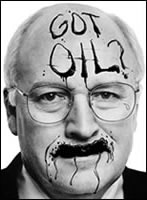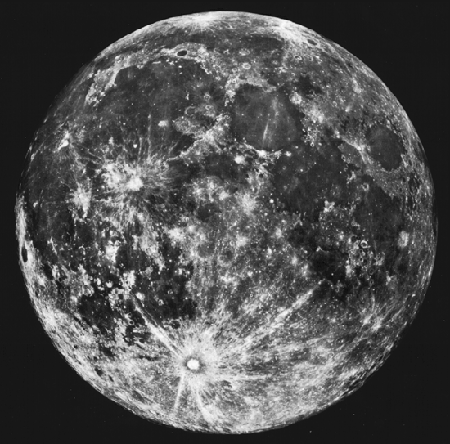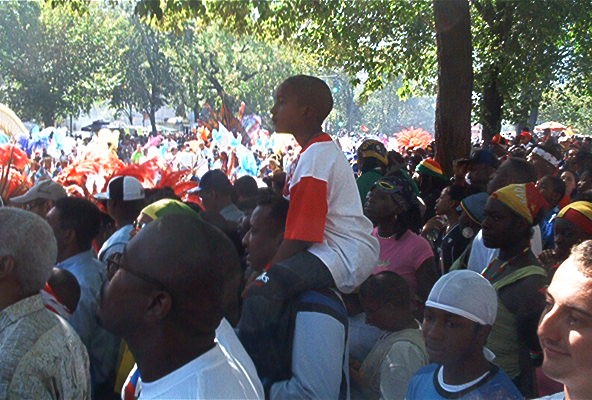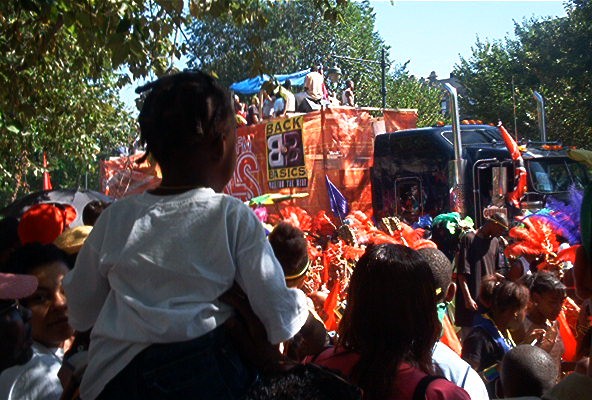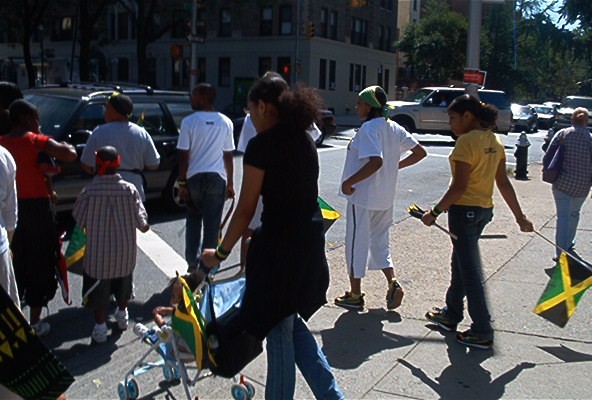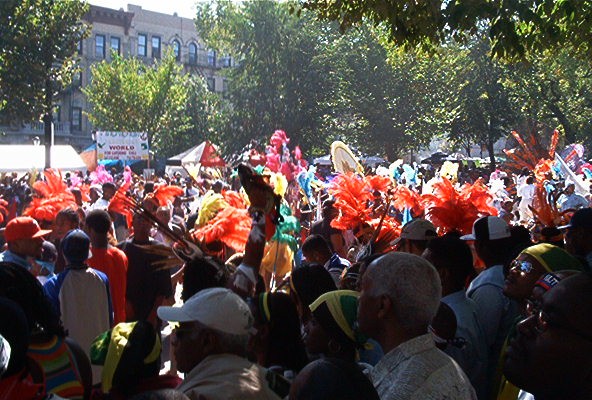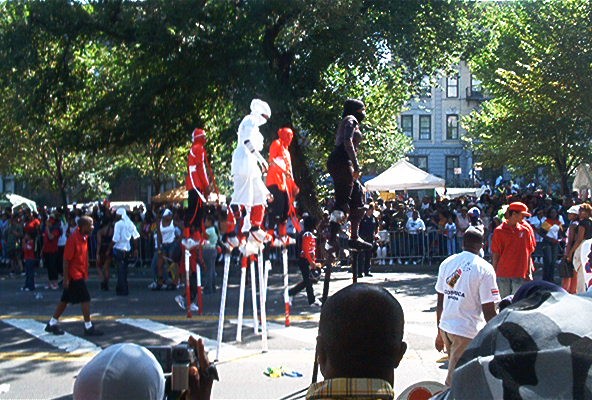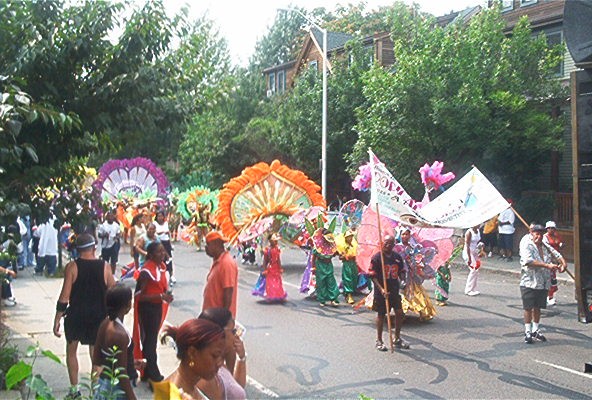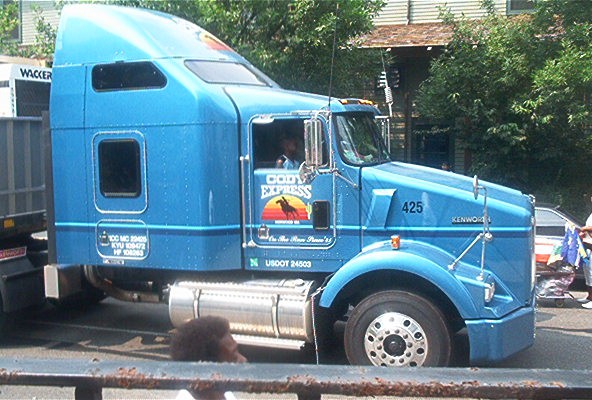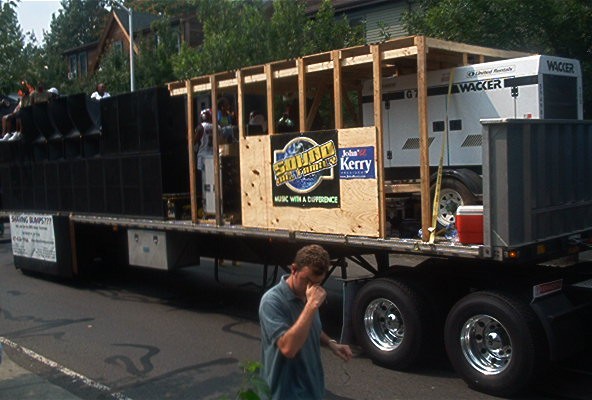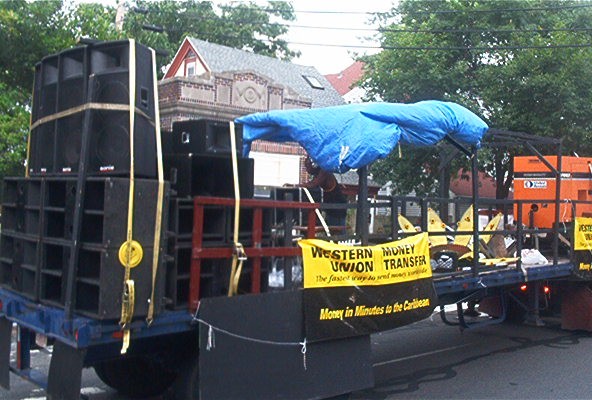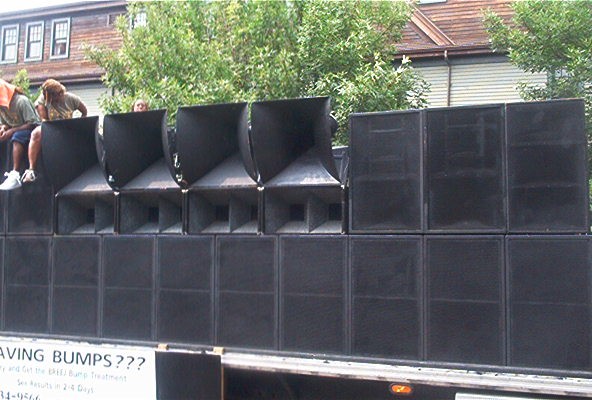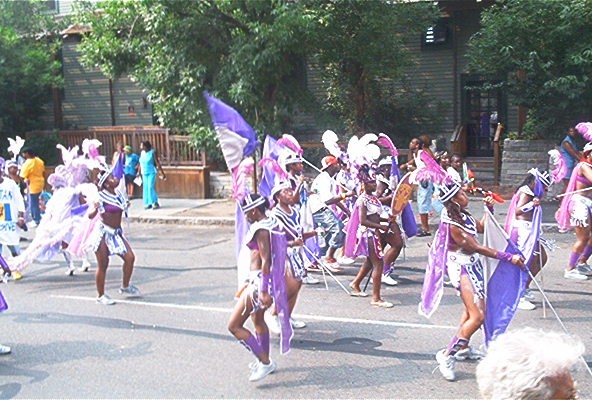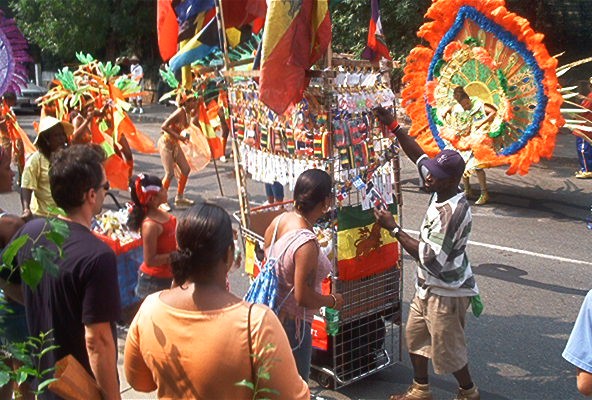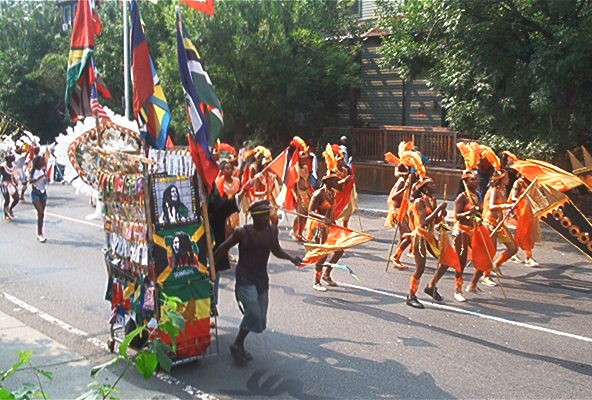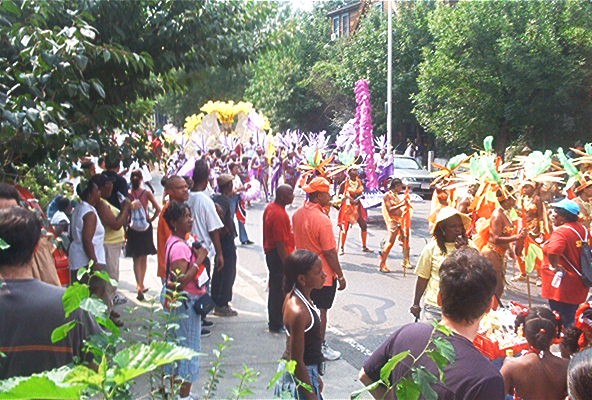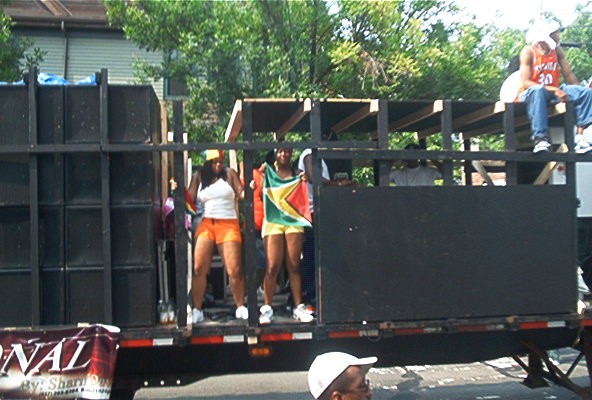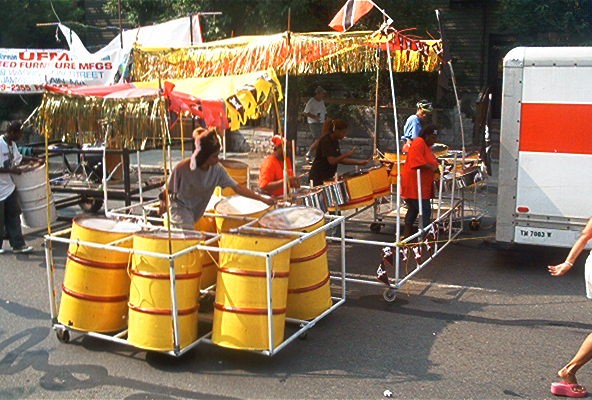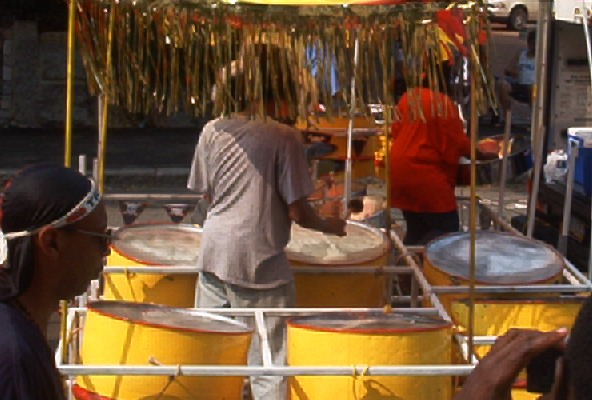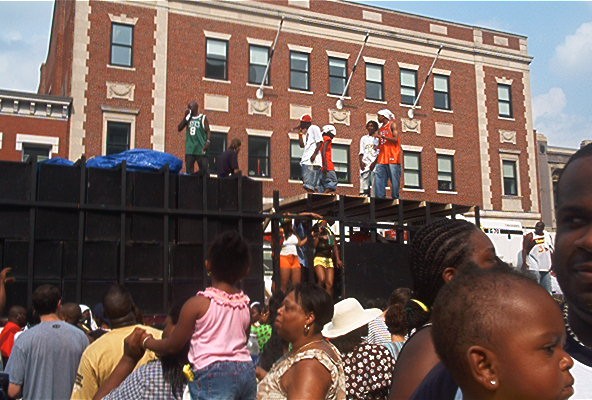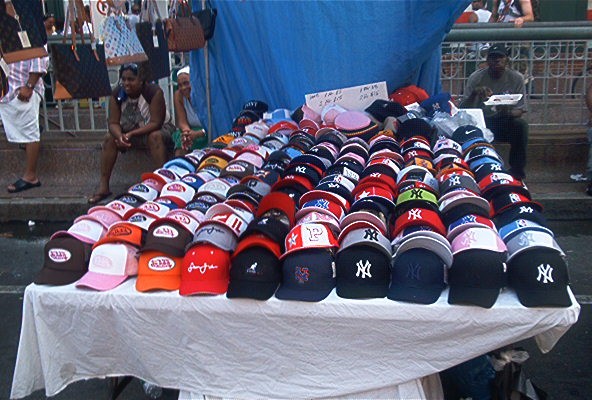(((re:sound)))
from september 16 to november 18, you can check out an exhibit called self-sufficient at the city hall annex gallery (344 broadway, cambridge). the theme of the exhibit is "site/non-site" and it features a number of works that reflect on this theme: videos revealing the vehicle-assisted production of paintings show alongside the paintings themselves (you have to see this one--it's a bit tough to describe); personal biospheres, which will later be "adopted" and worn around town, hang in the gallery for folks to try out; and a large black cube, whose contents one can only see (and manipulate) on the web, sits cryptically in the corner.
the (((re:sound))) project finds its place in the exhibit as an on-site display of text, images, and sound representing "renegade soundsystem culture" and an off-site "renegade soundsystem party" that will take place on october 16, featuring performances by yours truly, local fields, sosolimited, dj flack, hrvatski, duotone, and dj c. in good ol' rave style, in order to find the party one will need to tune in to 89.3 FM, which will only be broadcast in the union square area of somerville between the hours of 8-10 on the night of the event. the broadcast will reveal the location of "the map point," where one can obtain "the map." cheaters can check this site on the day of the event, but participation in the union square pirate radio broadcast is strongly encouraged. also, a week earlier, on october 8, there will be an interactive listening event at the gallery during which DJ C will spin some tunes, DJ Flack will demo some of his flash/video music, and I will deconstruct and reconstruct beats from around the world.
(((re:sound))) was inspired by, and takes as its subject, the "renegade sound system" parties that took hold in kingston in the 60s, the bronx in the 70s, and london in the 80s. it also attempts to make sense of boston's contemporary scene within this context. the folks putting together the exhibit--a group of somerville-based artists called circlesquare--asked me to contribute some text for the panels describing each of these scenes. i found it to be quite a challenge--and a good exercise--to describe each of these rich, complex scenes in a single paragraph. for one thing, i'm wary of oversimplifying or romanticizing these historical moments. to add to the challenge, at the time of writing i was down the cape, so i had to construct these "blurbs" off the top of my head, which proved to be another good exercise. as i am continually reminded these days, the ability to express an argument or a narrative in the most concise manner reflects one's command of it.
so, that said, i decided to share my blurbs with the general public because i do think they represent good little summations of what was going on in these moments and what was significant about them. my own interests and background reveal themselves here no doubt. you will note, for instance, that i underscore the jamaican connections across these moments and that my take on the rave scene reflects my lesser knowledge of that phenomenon. (i'll catch up soon enough, though. gotta get through generation ecstasy first, for one.) anyway, hope you enjoy.
Kingston in the 1960s
When they began to appear around Kingston in the 1950s, sound-systems typically comprised a set of large, powerful speakers, a turntable or two, and a microphone. In the 1960s sound-systems rose to prominence in downtown Kingston and forever transformed Jamaican music and culture. Kingston’s burgeoning urban population, in particular the lower-class denizens of “downtown,” flocked to the dances put on by such entrepreneurs as Clement “Coxsone” Dodd and Duke Reid. The intense competition between sound-systems led to a number of innovations, technical and musical. Speakers, for instance, which were often custom built by and for an individual sound-system, attained new heights of loudness, clarity, and frequency separation (i.e., bass, treble, and mid-range). King Tubby, an engineer/producer who went on to become one of the leading producers of dub, made his name as the operator of a sound-system with impeccable sound projection. This was the era when the pull-up (rewinding a well-received record to the beginning and starting it again) and talk-over (using a microphone to talk, rap, or sing over a record, or send “shout-outs”/“big-ups”) emerged as common practices. Soon dub-plates (instrumental versions of popular songs) and “specials” (unique records made to promote a particular sound-system) appeared, making it possible for a sound to distinguish itself in a competitive field. The practice of removing a record’s label to hide its identity—something hip-hop DJs would do in the 70s—also started in 60s Jamaica. The first records played on sound-systems were American R&B records, especially the boogie-woogie-driven songs of Fats Domino and Louis Jordon. Before long, partly in an attempt to gain an edge over local competitors, sound-system operators got into the recording business, cutting tracks with Jamaican artists. Audiences loved these early attempts at Jamaican R&B, despite their sometimes awkward imitations of northern style. Before long, a more Jamaican sound emerged from these experiments and R&B gave way to ska, which eventually morphed into rocksteady, reggae, dancehall, etc. Having severed colonial ties with Britain, at least nominally, the 60s were the years of independence in Jamaica, and the sound-system dances and the music emerging from them expressed both excitement about new social and political possibilities and frustration with lack of real change for the majority. Sound-system dances served as counter-cultural spaces for contesting the status quo, for asserting an Afro-Jamaican aesthetics, and for affirming the lives of lower-class “sufferers”—the urban poor not served by the promises of independence. The dances were spaces for individual and collective expression: people dressed up, invented and perfected new steps, chatted ’pon the mic in local language, and attempted to transcend the everyday struggles of ghetto life. The sound-systems’ powerful presence infused Kingston’s social spaces with a palpable and undeniable force. Sometimes banned or “locked-off” as “night-noise,” sound-systems nevertheless persevered, winning converts “uptown” and nurturing a local music industry that would reverberate around the world with the international reach of Bob Marley and the many artists, from Yellowman to Sean Paul, who followed in his trail. The techniques of reggae production and performance (e.g., dub-style, selecting/DJing, and toasting/rapping) have infused the world’s popular musics, and the technologies of the sound-system have spawned similar counter-cultural and popular movements, from hip-hop to rave.
Bronx in the 1970s
The Bronx-based park-parties that gave birth to hip-hop can be seen as a direct transmission of Jamaican sound-system style to New York. Jamaican immigrant Clive Campbell, a.k.a. Kool Herc, grew up in Kingston before moving to the Bronx in 1967 at age twelve. When he began to DJ his first parties in the mid-70s, he drew on the techniques and technologies of the sound-system. When Bronx audiences failed to respond to reggae, Herc substituted funk, soul, and disco records, inspiring b-boys, or break-dancers, by extending the brief rhythmic “breaks” of these tracks. The isolation and extension of the “break”—which Herc accomplished by alternating between two versions of the same record on two turntables (a trick inspired by Jamaican sound-system practice)—may be Herc’s and hip-hop’s greatest gift to the world of popular music. By turning these percussive solos into infinite loops, DJs such as Herc essentially created new compositions on the spot. The sample-based collages that hip-hop producers have favored since the early 80s represent a further extension of this technique, and DJ-based forms of all sorts, from ragga-jungle to the most mainstream electronica (not to mention pop and rock groups looking for a “modern” sound), have drawn on this approach for manipulation of pre-recorded sound. Herc also modeled his “shout-outs” and exhortations—a kind of proto-rapping, which MCs later elevated to an art in itself—on sound-system selectors’ talk-over toasts, enhancing the Jamaican cadences with rhymes and rhythms drawn from various African-American traditions. On the technological side, Herc became known for his unbeatable speakers, the “Herculoids,” which provided not only loud sound, but a clear separation of treble, bass, and mid-range frequencies, making for the most powerful musical presentation around. Soon his dominance would be contested by such luminaries as Afrika Bambaataa and Grandmaster Flash—both, significantly, of West Indian heritage—who extended Herc’s imported methods, inventing scratching, beat-juggling, and other turntable techniques that now comprise the basic vocabulary of hip-hop DJs. The hip-hop parties of the late 70s, like their Kingstonian antecedents, constituted entrepreneurial ventures, community events, and counter-cultural interventions for the urban poor. Using the resources at hand (e.g., consumer electronics) and the spaces available (from parks to gyms to clubs), young people in the Bronx transformed a post-industrial wasteland into a vibrant place and, in the case of Afrika Bambaataa’s Zulu Nation, channeled inter-gang strife for creative competition. Before long the movement spread to and merged with similar happenings in other boroughs, and soon to other cities in the U.S. and every country in the world. Today, sound-system events in Kingston are as likely to bear the influence of hip-hop style as the early Bronx parties of the 70s were to include dancehall practices.
London in the 1980s
As one of the major locations for the Jamaican diaspora, England—and London in particular—have long been familiar with sound-system technologies and techniques. Ska and reggae had been embraced by British youth since the early 60s, although the late 70s—especially the advent of punk and “two-tone”—represented a more intense level of (inter-racial) musical engagement. Rave culture emerges partly from the influence of Jamaican-style sound-systems, many of which were operated by first- or second-generation Jamaicans living abroad. Later (in the early- to mid-90s), an infusion of Jamaican style would lead to the creation of ragga-jungle, which persists as a style and subculture today alongside its cleaned-up cousin, drum’n’bass. Musically, however (at least in the mid- to late-80s), rave style was more closely related to Chicago house—especially the “acid” house produced with the Roland TB-303 synthesizer—and Detroit techno, two disco-derived forms developed in black, underground, and, typically, gay clubs. Tracks such as Strings of Life by Derek May provided the uptempo, climactic template for the increasingly “industrial” sound of rave music, propelled more and more by the ubiquitous and distinctive “hoover” synth and the common use of “dance” drugs such as ecstasy. At least in the early days, raves took place in warehouses and other large, abandoned spaces on the outskirts of London. Scavenger-hunt-like directions were given out to thwart the authorities, who occasionally shut-down raves, seized musical equipment, and sometimes arrested participants. As collective events on a grand scale, raves created the feeling of community for middle-class youth, countering the alienation and cynicism so common in modern urban life. P.L.U.R.—an acronym for “peace, love, unity, respect”—became the ideal, if cliché, embodiment of rave philosophy. By the mid-90s, raves had spread worldwide, and rave culture—alongside such international forms as reggae and hip-hop—remains one of the more popular and surprisingly coherent (i.e., shared from place to place) global musical and cultural styles.
Boston today
The soundscape of contemporary Boston is vibrant, if somewhat fragmented—perhaps reflecting the city’s sordid history of (class- and race-based) segregation. The puritanical “blue laws” also have something to do with the lack of a developed local scene, as clubs are forced to close earlier than in many major cities and few public spaces are either suited or available for performances. One finds a great deal of variety across Boston’s soundscape, but little unity or momentum, even within subcultural scenes. On any given night one can find great hip-hop, reggae, soca, salsa, jazz, indie rock, drum’n’bass, punk, metal, worldbeat, or a variety of other genres. There is also quite a bit of cross-fertilization between these scenes: the reggae and hip-hop crowds melt together, electronic dance musics often stand side-by-side, latin dance genres often occupy the same spaces, and a growing number of eclecticists draw on all of these styles to create their own local gumbo. Nevertheless, the reggae scenes of, say, Cambridge and Dorchester rarely mix, and Boston has yet to put itself on the map as a place with its own “sound.” A strong collection of college radio stations provide good alternatives to the so-called “clear-channels” of mainstream programming, and a host of small clubs and pubs provide decent, intimate performance spaces for small scenes with loyal followings. With a young, highly-educated, and diverse population, plenty of resources, and no end of talent, there would seem to be quite a bit of potential in Boston. It remains to be seen whether this potential can coalesce in the same way as happened in 60s Kingston, 70s Bronx, or 80s London. As these cases suggest, it might behoove Bostonians to embrace the various musical and cultural strands that constitute our distinctive local mix. The world is in Boston. Can Boston show this to the world?




